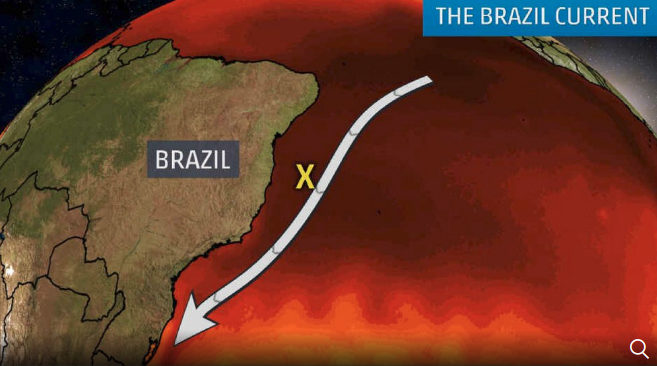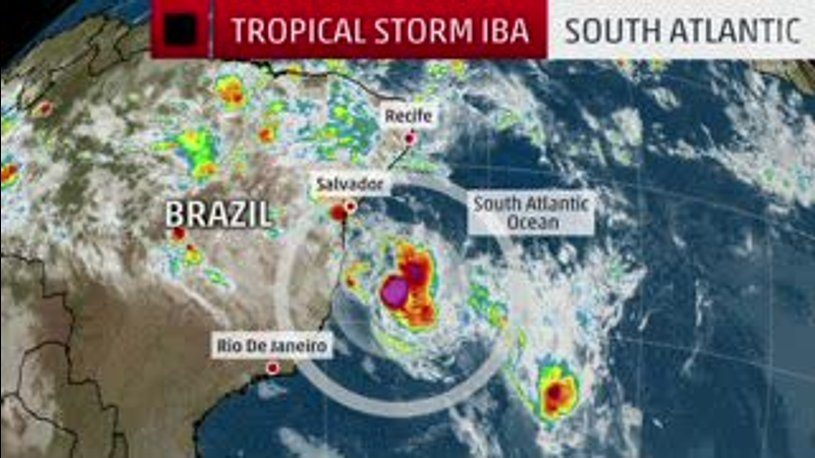A disturbance off the coast of Brazil has become the first South Atlantic tropical storm since 2010.
On Sunday, the Brazilian Navy Hydrographic Center (BNHC) analyzed Tropical Storm Iba as being located about 600 miles northeast of Rio de Janeiro, Brazil, or just off the coast of the states of Bahia and Espirito Santo, Brazil. Satellite imagery shows concentrated shower and thunderstorm activity near the area of low pressure.
Computer models suggest that this system will become better developed as it drifts south and eastward, possibly attaining sustained winds of 40-50 mph, according to the BNHC. Iba is not expected to become a hurricane.
The name "Iba" was drawn from the single list of names maintained by the BNHC.
A New Understanding of South Atlantic Cyclones
Scientists long thought that tropical cyclones were absent from the South Atlantic, but a pair of climatology studies published in the Journal of Climate in 2012 and 2014 found that subtropical cyclones off the Brazilian coast are actually quite common.
"On average about one of these subtropical cyclones forms each year in the South Atlantic," said hurricane specialist Michael Lowry. "So in that sense, it's not that unusual. If it becomes purely tropical, that would be unusual."
Until recently, it was commonly believed fully tropical cyclones did not form in the South Atlantic Ocean for two main reasons.
First, wind shear is typically too strong there. Wind shear pushes thunderstorms away from any area of low pressure trying to develop, instead of letting convection cluster near the low.
Secondly, while tropical waves - disturbances not yet well organized - can act as seeds of tropical development as they roll westward from the coast of North Africa into the North Atlantic Ocean, no such tropical waves roll west off Africa south of the equator.
The lack of regularly observed systems in the South Atlantic have created somewhat of a confirmation bias for the basin, but research released in 2012 found that 63 subtropical cyclones had actually formed between 1957 and 2012, or about one subtropical cyclone every year.
Contrary to the northern Atlantic, which has a hurricane season defined as extending from June through November, there is no preferred time of year for development in the southern Atlantic.
This difference is somewhat due to the lack of variability in wind shear throughout the year. In the North Atlantic, wind shear drops from July through October, whereas there is little to no change in the South Atlantic.
South Atlantic Tropical History
Prior to the 21st century, no hurricane had ever been confirmed in the South Atlantic Ocean.
In late March 2004, however, wind shear was low off the eastern coast of South America as an upper-level low-pressure system was sprouting thunderstorms near its center.
Making the transition to a tropical cyclone, what was later called Hurricane Catarina turned back westward, making landfall in the Santa Catarina province of Brazil as a Category 1 equivalent on March 27, 2004.
According to the final summary by E.V. Marcelino and colleagues, just over 38,000 structures were damaged and another 1,468 collapsed. Despite the freak nature of this storm, some residents evacuated from the coast.
After Catarina, forecasters and researchers began to pay closer attention to the South Atlantic. The first name list for subtropical and tropical cyclones in the South Atlantic appeared in 2011.
In 2018, the BNHC expanded the alphabetical list from 10 to 15 names for tropical and subtropical cyclones forming in the western part of the South Atlantic Ocean. From the first list, the first name, Arani, was used in March 2011; Bapo and Cari were named in early 2015. Deni was used in November 2016. Eçaí and Guará were used in the Decembers of 2016 and 2017, respectively. All six systems were subtropical storms.
The next four names are Iba, Jaguar, Kamby and Mani.
The last such true tropical storm formed in the basin in 2010 when Tropical Storm Anita, which was more informally named, formed on March 10 near the coast of Brazil.
How Systems Form in the South Atlantic
Most of the tropical and subtropical cyclones observed in the South Atlantic have developed near or over the warm Brazil Current, which flows southwestward from the equator along the east coast of South America. This is somewhat analogous to the Gulf Stream, which flows along the Southeast Coast of the United States.

In the South Atlantic, subtropical systems get some assistance from the Andes Mountains. As systems roll off the coast of South America, they gain spin as they "drop" off the Andes and then hit the warm-enough-waters in the Brazil Current and develop. In the Atlantic, systems may roll off the Appalachians and reach the Gulf Stream, but mainly in cooler months, when the offshore waters are often too cool to support development.
Other subtropical cyclones form in a very similar manner to the North Atlantic. The jet stream occasionally leaves low pressure systems behind, and they can become subtropical systems as their circulations become more symmetric and more influenced by warm ocean waters.





Comment: There have been a number of unusual and destructive storms in recent weeks: